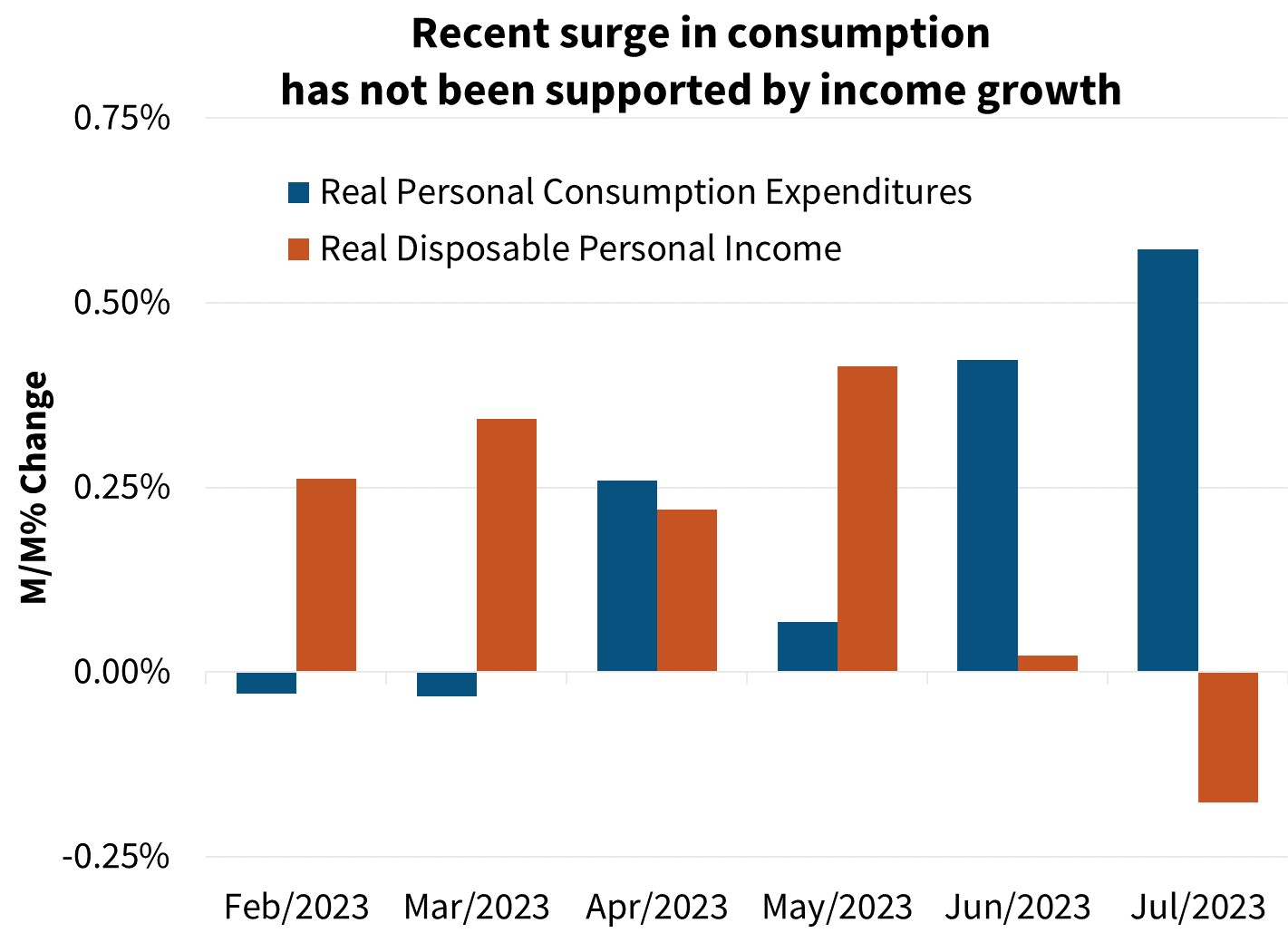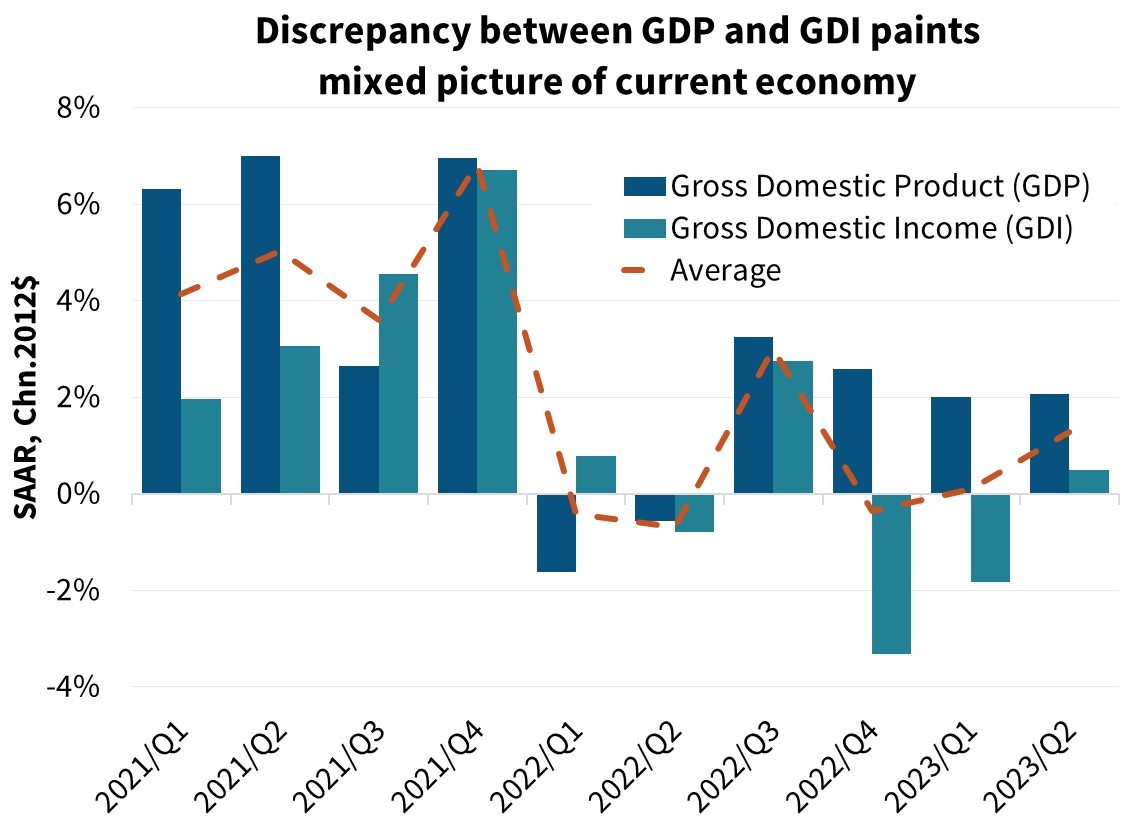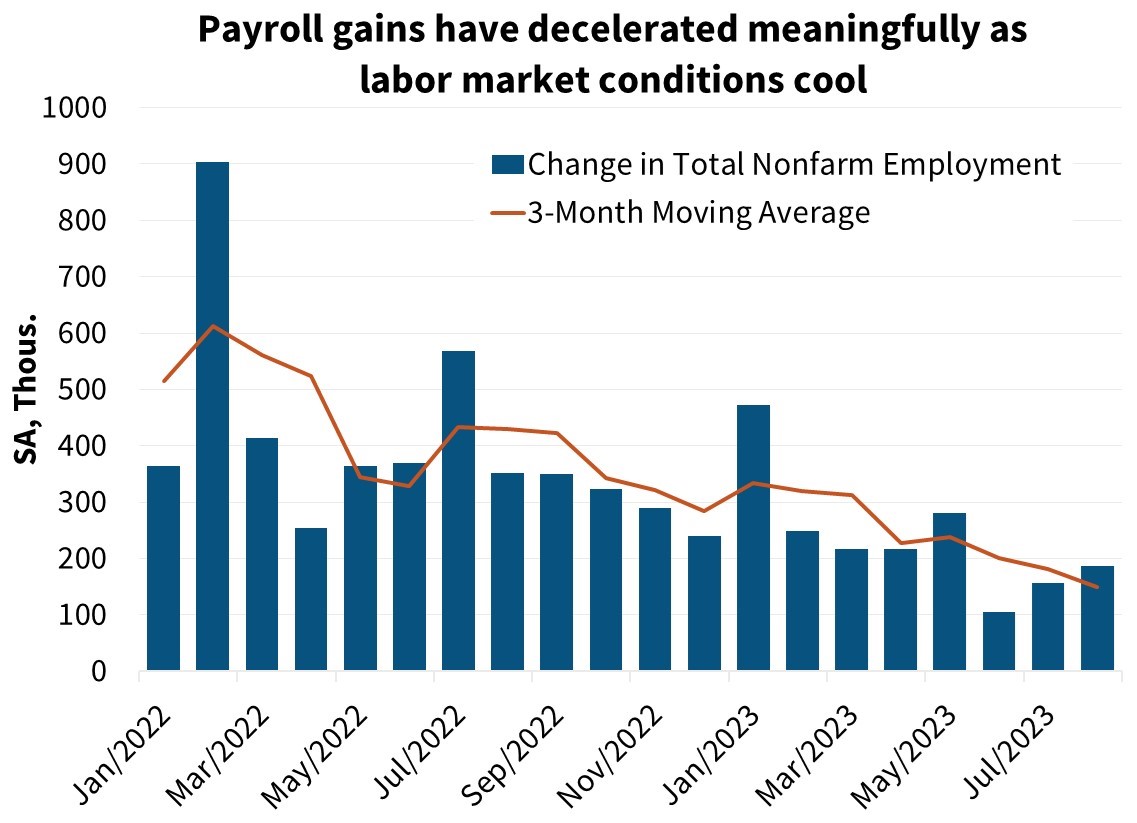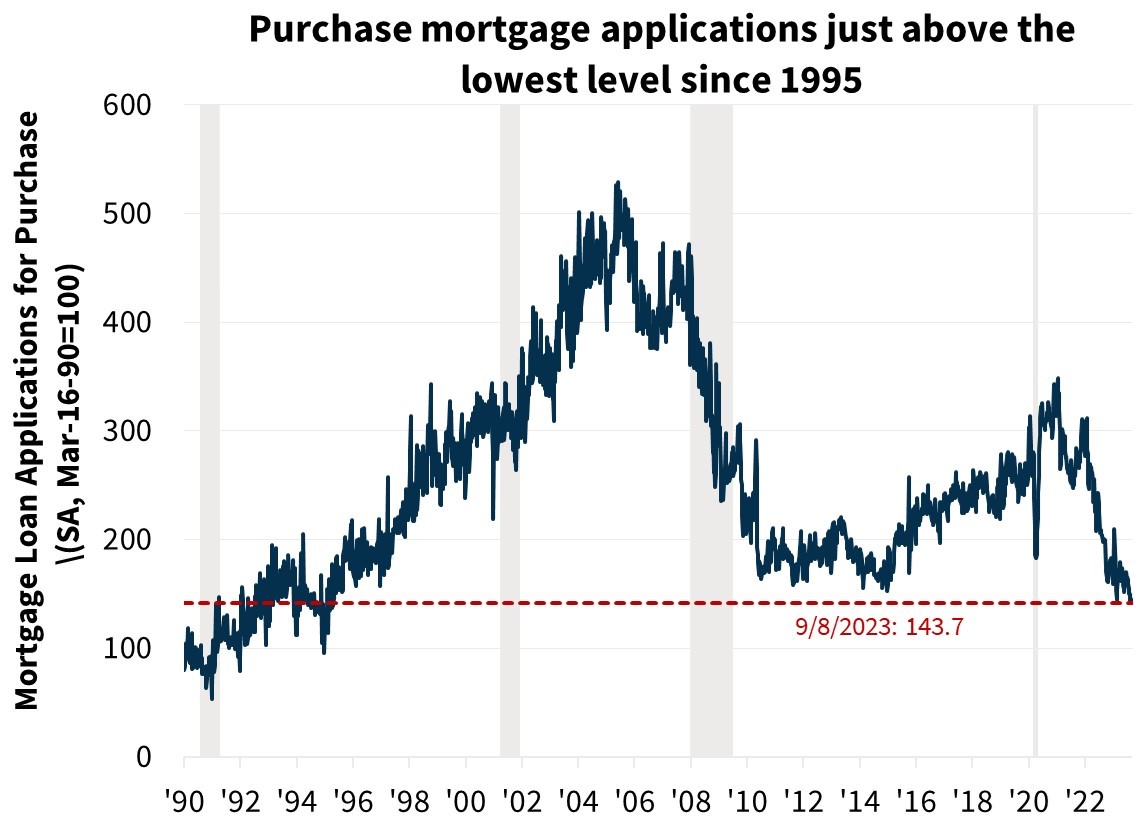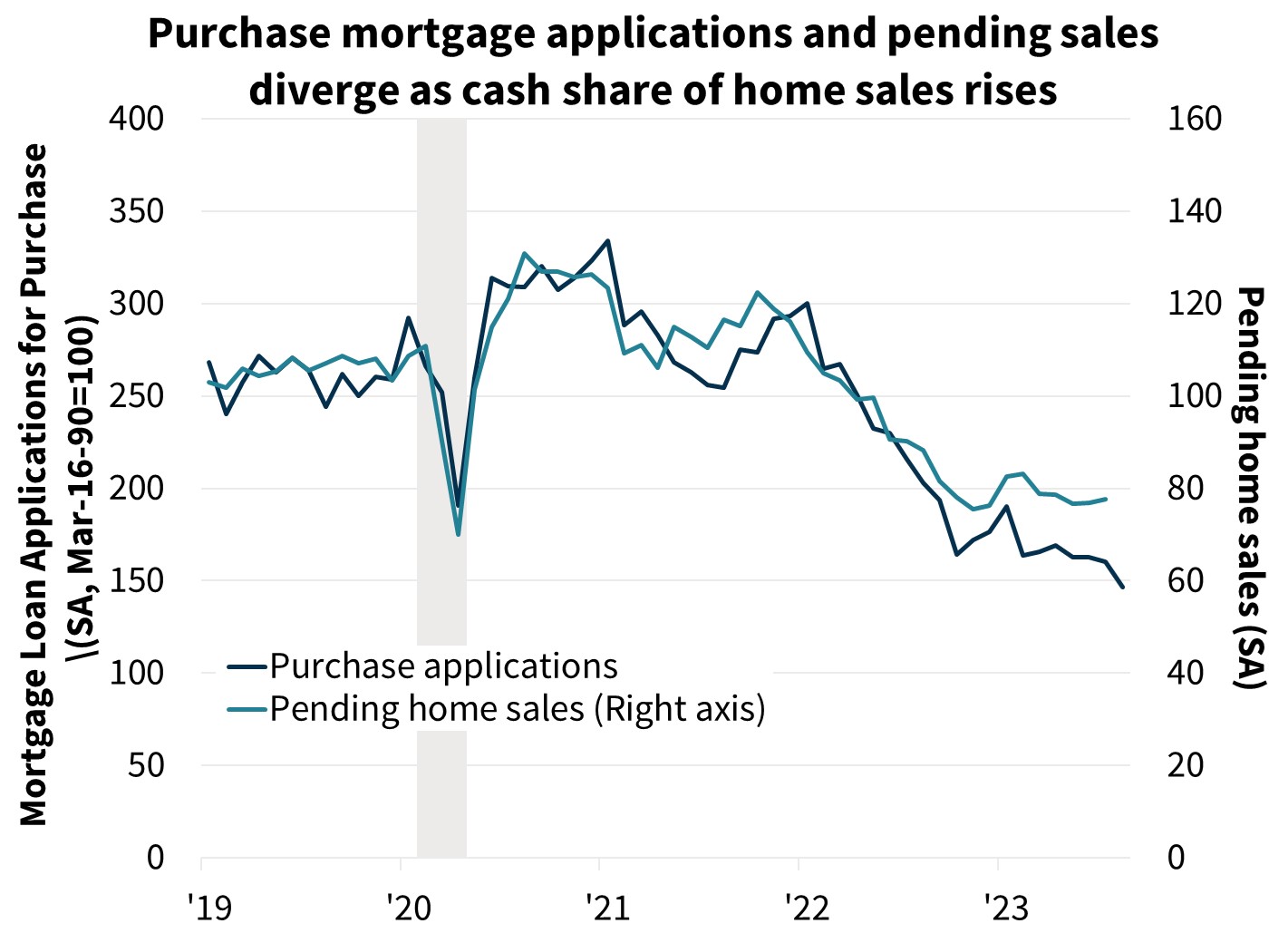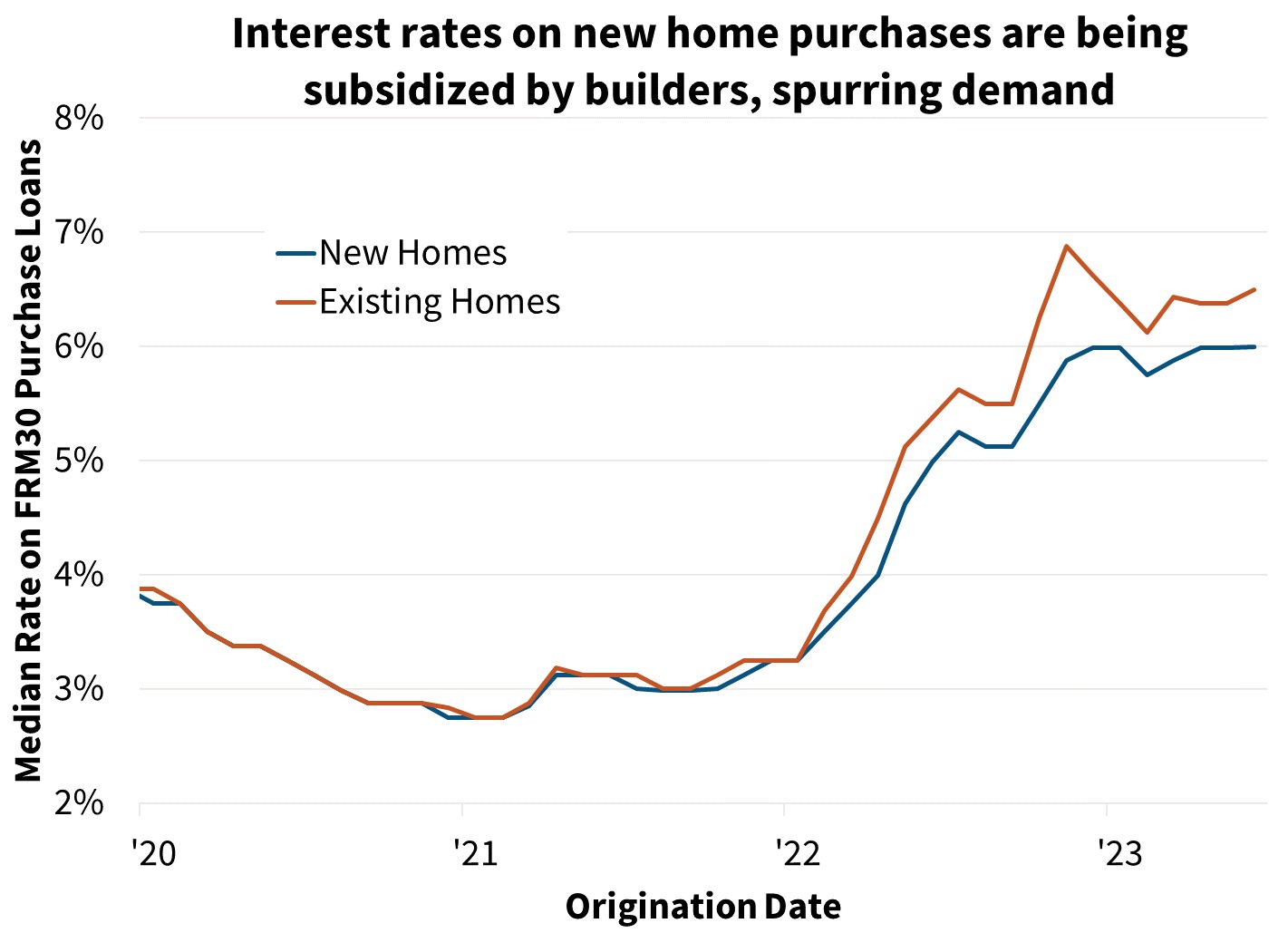Housing Faces Mortgage Rate Headwinds as Economic Growth Likely Tempers
We maintain our forecast for a modest economic contraction in the first half of 2024. Fundamentally, personal consumption remains at what we believe to be an unsustainable level relative to incomes, and the full effects of monetary policy tightening are still working through the economy. We have upgraded our 2023 real GDP growth outlook to 2.2 percent from 1.9 percent on a Q4/Q4 basis largely due to incoming July data, while our forecast for growth in 2024 is unchanged. Meanwhile, we forecast the topline and core measures of the Consumer Price Index (CPI) to end the year around 3.1 percent and 4.0 percent in 2023, respectively, slowing further in 2024 to 2.4 percent and 2.5 percent.
With the jump in mortgage rates to above 7 percent, the housing market faces renewed headwinds. Mortgage origination activity has slowed further in recent weeks and total home sales remain at levels not seen since 2011. The new home market, which showed surprising strength over the first half of 2023, due in part to a limited inventory of existing homes for sale, may now be taking a breather. We forecast total home sales to be around 4.8 million in 2023, which would be the slowest annual pace since 2011 and 4.9 million in 2024. Similarly, our expectation for 2023 mortgage originations was downgraded from $1.60 trillion to $1.56 trillion in 2023 and from $1.92 trillion to $1.88 trillion in 2024.
Q3 GDP Growth Poised to Accelerate, but Strength is Likely Temporary
The third quarter started off on a strong note, with real personal consumption jumping 0.6 percent month over month in July, pointing to a stronger Q3 2023 GDP growth figure than previously anticipated. Even if personal consumption expenditures were to remain flat over the next two months, July’s growth alone would translate into a pace of personal consumption over the quarter of around 3.8 percent annualized. However, this surge in spending is likely unsustainable and our outlook is for decelerating activity. We believe much of the July consumption was the result of pulling forward future spending in part due to a combination of the release of popular movies and concerts as well as an increase in spending on energy during the July heat waves, and perhaps due to seasonal timing related to online retailer sales. Both recent credit card transaction data and auto sales data point to a likely pullback in consumption in August, with auto sales falling 4.6 percent month over month. August nominal retail sales jumped by 0.6 percent, but this was almost entirely due to price increases in gasoline. Control group retail sales, which feed into the GDP report, rose by only 0.1 percent in nominal terms, suggesting flat or slightly declining real sales. Furthermore, the 0.6 percent pop in real consumption in July came despite a decline of 0.2 percent in real disposable income, increasing the divergence between the two series. Recent spending growth has come via a further reduction in the already below-trend personal saving rate to 3.5 percent in July. This was down from 4.3 percent in June and around an average of 8.0 percent from 2017 to 2019. Especially when accounting for an expected deceleration in wage growth, we expect more modest consumer spending growth in coming quarters.
Complicating the outlook currently, much of the recent data paints a muddied economic picture. Real GDP in the second quarter was revised downward by 0.3 percentage points but still reported as a solid 2.1 percent annualized pace. However, gross domestic income (GDI), which is a theoretically equivalent measure of economic activity but can diverge in practice due to imperfect measurement and incomplete data, was reported to have grown only at a 0.5 percent annualized rate in the second quarter. This is significantly weaker than the Q2 GDP figure, though an improvement from the negative 3.3 percent and negative 1.8 percent annualized growth rates in the prior two quarters, while GDP averaged a 2.3 percent annualized growth rate during the same period. This is a historically wide divergence between these series. While some of the discrepancy can be explained by accounting differences with regard to Federal Reserve Bank losses from paying higher interest on reserves, the gap between GDP and GDI shrinks only marginally when making such an adjustment. As such, the significant divergence between GDP and GDI makes our interpretation of recent data less clear than it typically would be, adding additional uncertainty to our current outlook.
In the past, large discrepancies between GDP and GDI have typically been at least partially revised away during benchmark revisions. This presents downside risk to our 2023 GDP expectation. A 2023 research note from the Cleveland Fed found that the initial difference between GDP and GDI is predictive of eventual benchmark revisions to GDP but is not predictive of revisions to GDI, suggesting GDI may be the more reliable indicator when the two measures diverge.
Inflation Decelerating as Labor Market Cools; Can it Level Off?
The CPI jumped 0.6 percent over the month in August, the largest monthly increase since June 2022. This was an acceleration on a year-over-year basis to 3.7 percent from 3.2 percent in July. The jump, however, was mostly due to a 10.6 percent surge in gasoline prices over the month. Core inflation was more subdued, rising a lesser 0.3 percent over the month, partially driven by an also-energy-related 4.9 percent increase in airline fare and still lagging shelter price growth. Favorable base effects in the core index caused the annual rate of inflation to decelerate by four-tenths to 4.3 percent. When looking at various rolling averages of the core index, as a whole, the CPI continues to support our expectation for a generally softening inflation trend when excluding volatile energy prices. The three-month annualized rate of the core CPI fell to 2.4 percent in August from 3.1 in July and 4.1 in June. If this is sustained, then overall inflation is already at or near the Fed’s 2-percent PCE deflator target. On an annual basis, we expect further deceleration in the core index as base effects become more favorable and measures of shelter prices continue to cool in line with more timely estimates of new rents, and labor market conditions continue to loosen.
Nonfarm payroll employment rose by 187,000 in August, though the prior two months were revised downward by a combined 110,000 jobs. After revisions, the three-month moving average of employment gains currently sits just below the average monthly payroll gain in 2019, and the unemployment rate, which rose 0.3 percentage points in August, now sits at its highest level in 18 months. While we are discounting the jump in the unemployment rate due to it being driven by a jump in the often-volatile measure of labor force participation rather than a decline in employment, it is clear after payroll revisions that the labor market has loosened in recent months. Average payroll gains over the past three months were 149,000, down from 312,000 in the first quarter of the year. Another data point consistent with a cooling labor market is that average hourly earnings growth decelerated to just a 0.2 percent month-over-month growth rate in August, down from the 0.4 percent growth rate in June and July. If sustained, this is a wage growth rate that is compatible with the Fed’s 2-percent inflation target given current productivity growth trends. More predictive going forward, the JOLTS report also showed job openings at their lowest level in July since April 2021 and a quits rate that has returned to its pre-pandemic level. The latter is highly correlated to future wage growth, and its recent declines suggest wage growth will be more modest in coming months.
While it is only one month of data, the August employment report struck a near-perfect balance between sufficient strength to prevent a recession but not so much strength that the labor market contributes above-target inflationary pressures. The question moving forward will be whether the labor market softening slows or continues right into net job losses. Based on history, we believe the latter is more likely, as the full effects of monetary policy tightening are still working through the economy, but if we were to change our recession call it would be due in large part to seeing several months of employment data that look like August.
It should also be noted that as of this writing there was uncertainty over whether the United Auto Workers would go on strike at the “big three” auto companies. Were this to occur for a sustained period of time, the scale is large enough to drive a negative payroll report in October, as well as dampen the GDP measure. A short-lived strike would likely be followed by a rebound in auto manufacturing output thereafter, but it’s worth noting the potential impact on economic data.
Higher Mortgage Rates Another Test for Home Sales
With the 30-year fixed mortgage rate staying above 7 percent in recent weeks, purchase mortgage applications have pulled back again and now sit near the lowest level since 1995. While existing home sales are expected to remain near their lowest level since 2009, further sales declines are likely to be less pronounced in relation to current increases in the mortgage rate. As more sales are driven by life events and fewer are from discretionary move-up buyers, we see limited further existing home sale downside. Additionally, the mortgage application measure and the pending home sales index are increasingly diverging, reflecting the higher cash share of sales. While the additional downside risk from rate movements to date is minimal, the prospects of a recovery in existing sales in the near future is unlikely given strong mortgage rate “lock-in” effects and stressed affordability.
While new listings have shown some comparative seasonal strength in recent weeks relative to the typical seasonal decline seen in recent years, the total number is still 9.3 percent below this time last year, according to Redfin. The speed at which listings sell has declined slightly, but it is still at a level reflecting a tight market. The median number of days on the market was 46 in August, up from 41 a year prior, according to Realtor.com. However, it still remains well below the 59 days recorded in August 2019, prior to the pandemic.
Existing home sales fell by 2.2 percent in July to a seasonally adjusted annualized rate (SAAR) of 4.07 million. This represented a 16.6 percent decline from a year prior. Pending home sales, which lead closings on average by 30-45 days, moved up slightly in July despite rising mortgage rates, suggesting August sales will be similar to July. Still, given the pullback in mortgage applications, we are expecting a modest dip in existing sales thereafter.
The recent rise in mortgage rates will also now test the resiliency in the new home sales market, which showed remarkable strength over the first half of the year. The lack of existing homes for sale has helped support demand for new homes, including an increasing share of first-time buyers. A big question will be to what extent homebuilders will continue to offer generous mortgage rate buydowns to drive sales. Looking at recent Fannie Mae mortgage acquisition data, there has been wide divergence in the average note rate of borrowers purchasing existing homes vs. new homes, reflecting homebuilders subsidizing the rate. When mortgage rates originally jumped to 7 percent in late 2022, a pullback in homebuilder activity ensued as buying activity slowed. It is uncertain whether this same rate threshold will result in a similar effect this time around or whether buyers and homebuilders have increased their willingness to purchase and subsidize at current rates. Perhaps telling, after rising for 6 months, the homebuilder confidence survey pulled back six points in August, suggesting some softening in new home sales and starts in the near term. While we anticipate new home construction to remain comparatively strong over the coming quarters given mortgage rates and the economic environment, we are still forecasting a modest pullback in new sales and starts. We expect fourth quarter new home sales to average around 691,000 units on an annualized basis, down slightly from the most recent pace of 714,000 in July.
Multifamily construction continues to show further signs of deceleration. Multifamily housing starts fell in August by 1.7 percent. While the series has been noisy in recent months, the more indicative permits figure continues to trend downward and, at 513,000 annualized units in July, sat at a level near the pre-pandemic 2019 average. With sluggish rent growth on a national level, more normalized vacancy rates, and tighter construction and development loan lending standards, we expect multifamily construction starts to continue to slow. These dynamics may also play into softening demand for single-family housing: There is a large pipeline of multifamily housing coming online, and the rent-to-buy calculus for prospective homebuyers may tilt a little more in favor of renting for longer.
Mortgage Originations Forecast Little Changed
We have revised downward our forecast for purchase mortgage originations this month given downgrades to the home sales forecast. In particular, we now expect purchase volumes to be $1.3 trillion in 2023, a downgrade of $30 billion from last month’s forecast. We expect purchase volume to rise to $1.4 trillion in 2024 as home sales increase, a downgrade of $29 billion from the prior forecast.
Given a higher expected mortgage rate path this month, we reduced our refinance forecast by $10 billion in 2023 to $251 billion and by $14 billion in 2024 to $442 billion. Refinance activity, as illustrated by the Refinance Application-Level Index (RALI), remains depressed given that mortgage rates remain above the 7 percent level.
Economic & Strategic Research (ESR) Group
September 14, 2023
For a snapshot of macroeconomic and housing data between the monthly forecasts, please read ESR’s Economic and Housing Weekly Notes.
Data sources for charts: Bureau of Economic Analysis, Bureau of Labor Statistics, Mortgage Bankers Association, National Association of REALTORS®, Fannie Mae
Opinions, analyses, estimates, forecasts and other views of Fannie Mae's Economic & Strategic Research (ESR) Group included in these materials should not be construed as indicating Fannie Mae's business prospects or expected results, are based on a number of assumptions, and are subject to change without notice. How this information affects Fannie Mae will depend on many factors. Although the ESR group bases its opinions, analyses, estimates, forecasts and other views on information it considers reliable, it does not guarantee that the information provided in these materials is accurate, current or suitable for any particular purpose. Changes in the assumptions or the information underlying these views could produce materially different results. The analyses, opinions, estimates, forecasts and other views published by the ESR group represent the views of that group as of the date indicated and do not necessarily represent the views of Fannie Mae or its management.
ESR Macroeconomic Forecast Team
- Doug Duncan, SVP and Chief Economist
- Mark Palim, VP and Deputy Chief Economist
- Eric Brescia, Economics Manager
- Nick Embrey, Economist
- Nathaniel Drake, Economic Analyst
- Richard Goyette, Economic Analyst
